Zeppole di San Giuseppe, or St. Joseph’s pastries, are Italian pastries made with choux pastry that’s piped, baked or fried, filled with pastry cream, and topped with a cherry. Typically made for the Feast of San Giuseppe, these pastries can (and should) be enjoyed all year long!
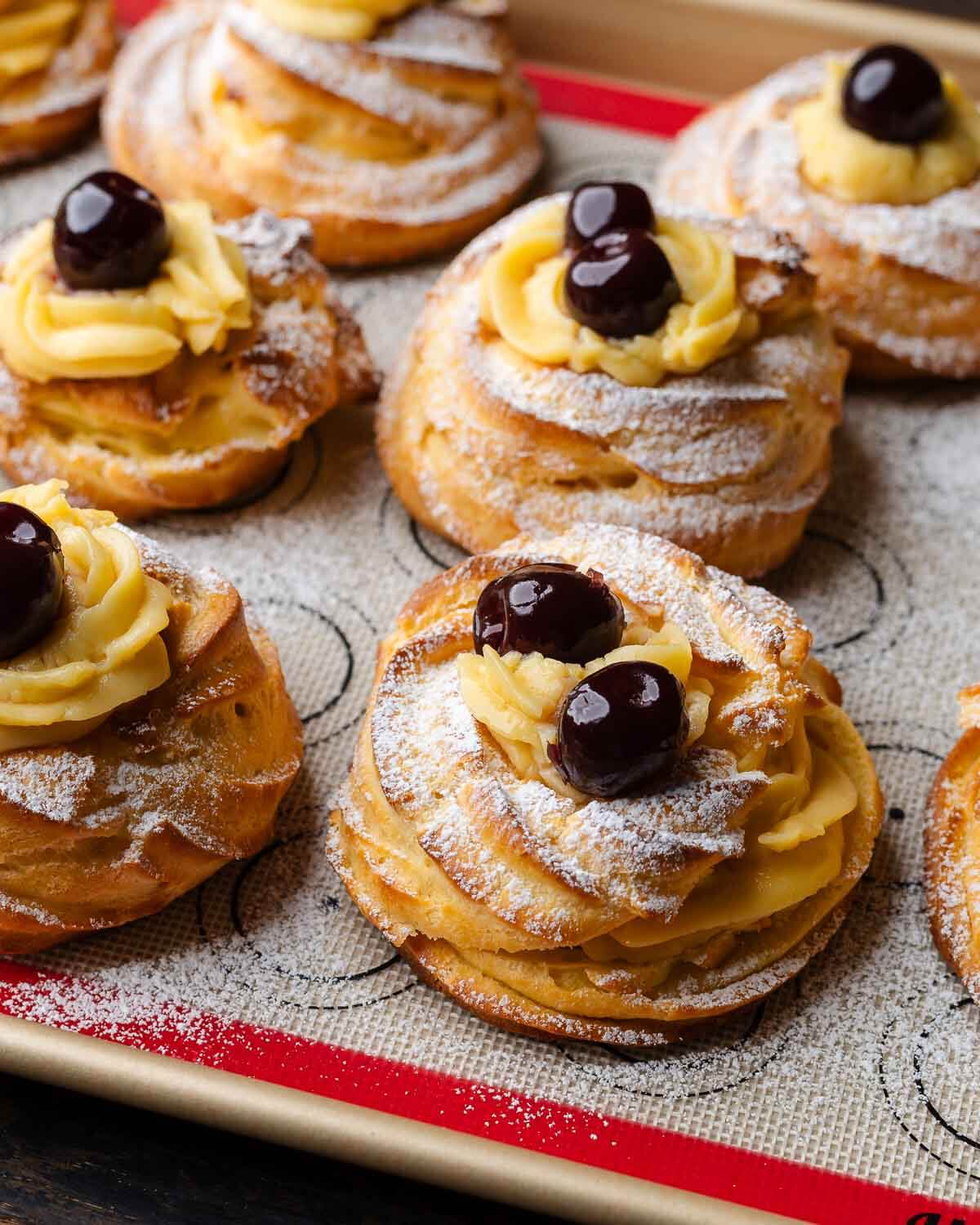
This post may contain affiliate links. Our disclosure policy.
For many Italians and Italian-Americans, March 19th marks the Feast of St. Joseph and is celebrated with food such as Zeppole di San Giuseppe and Pasta con le Sarde.
While they may look complicated, they’re quite simple to make and are so delicious!
While similar to cream puffs in that they’re made with a choux pastry, St. Joseph’s pastries are typically piped using a star tip, and then baked or fried until golden.
The pastry cream is also piped using the same star tip, dusted with powdered sugar, and followed with a cherry on top.
Want To Save This Recipe?
Table of Contents
Choux Pasty Ingredients
All ingredients for this recipe are shown in the pic below and special notes are made in this bulleted list to assist you.
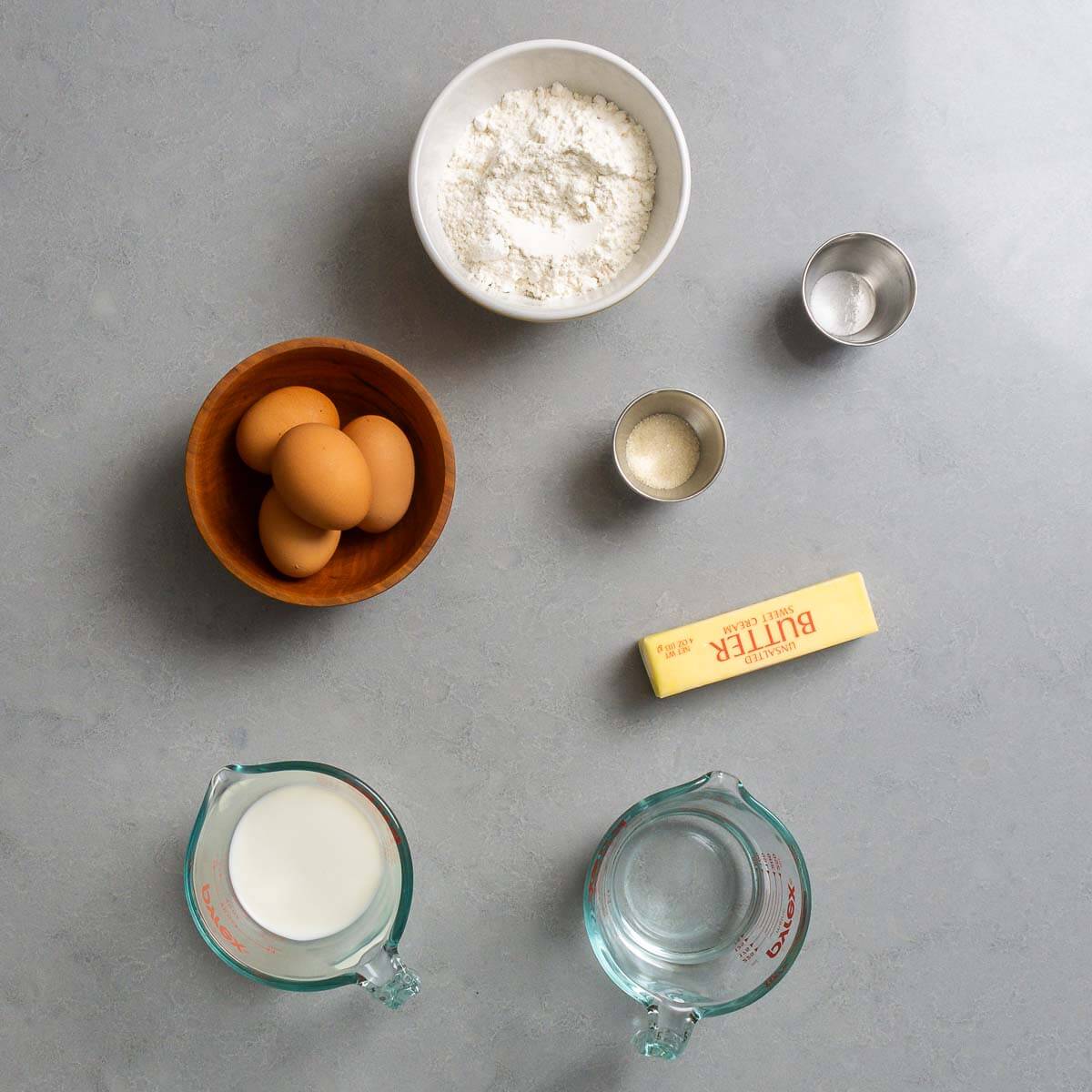
- Eggs. A main component of choux pastry dough.
- Flour. All-purpose flour is used for this recipe.
- Milk. Full-fat milk (whole milk) should be used for pate choux.
- Butter. Use unsalted butter.
See the recipe card for full information on ingredients and quantities.
Pastry Cream Ingredients
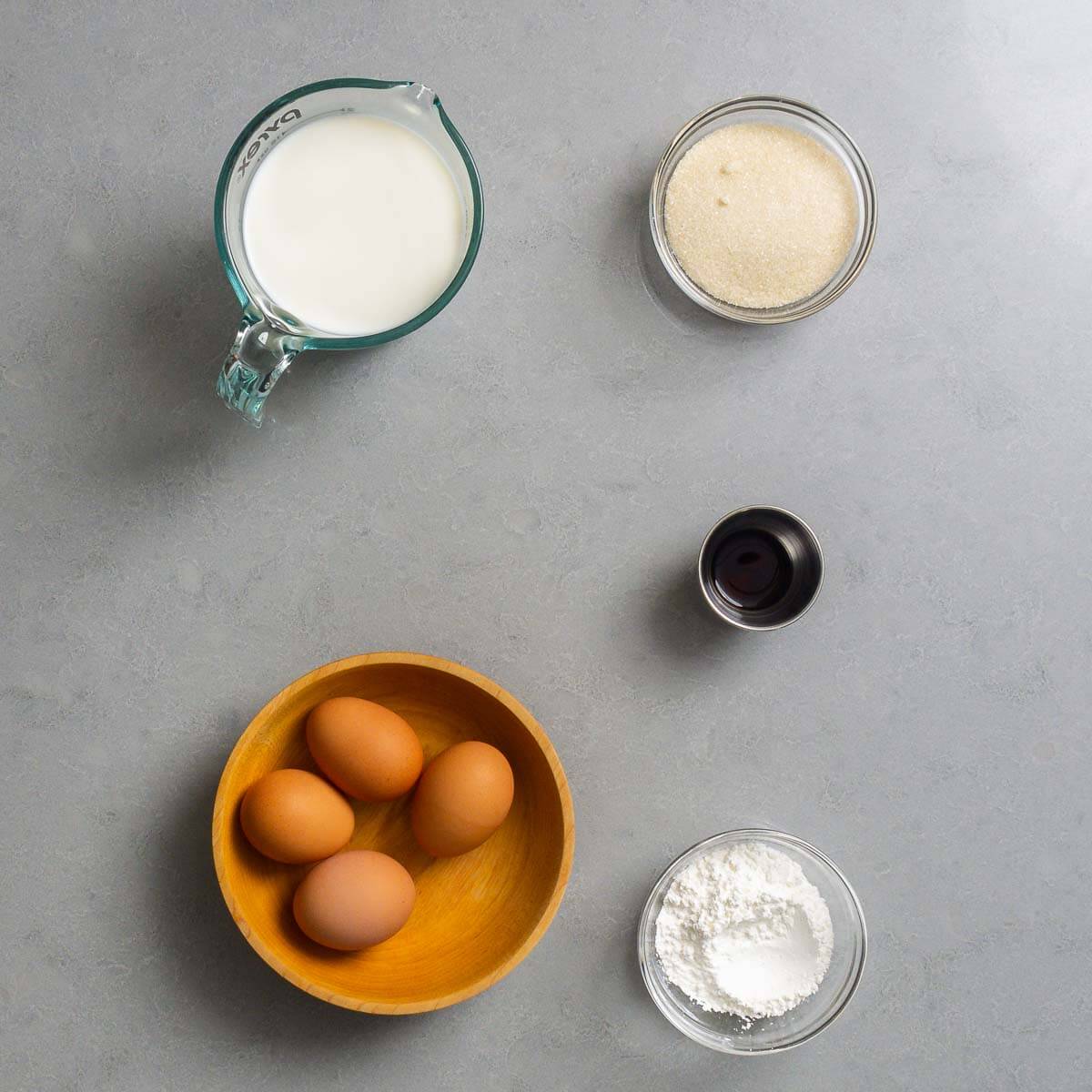
- Egg yolks. For a custard-like pastry cream. Use the remaining egg whites for a different recipe, such as pignoli cookies.
- Milk. Whole milk should be used for pastry cream and warming instructions are provided below.
- Cornstarch. To thicken the cream.
See the recipe card for full information on ingredients and quantities.
First, make the choux pastry (Pâte à Choux)
Each number corresponds to the numbered written steps below.
- Preheat the oven to 400f and set the rack to the middle level. Add 1 stick (115g) of unsalted butter, 2 teaspoons (9g) of granulated sugar, 1/2 cup (120g) of water, and 1/2 cup (120g) of whole milk to a large saucepan and cook on medium heat until the mixture comes to a boil. (Photo #1)
- Once boiling, add 1 1/4 cups (160g) of all-purpose flour and stir with a spatula until all the flour is incorporated. (Photo #2)
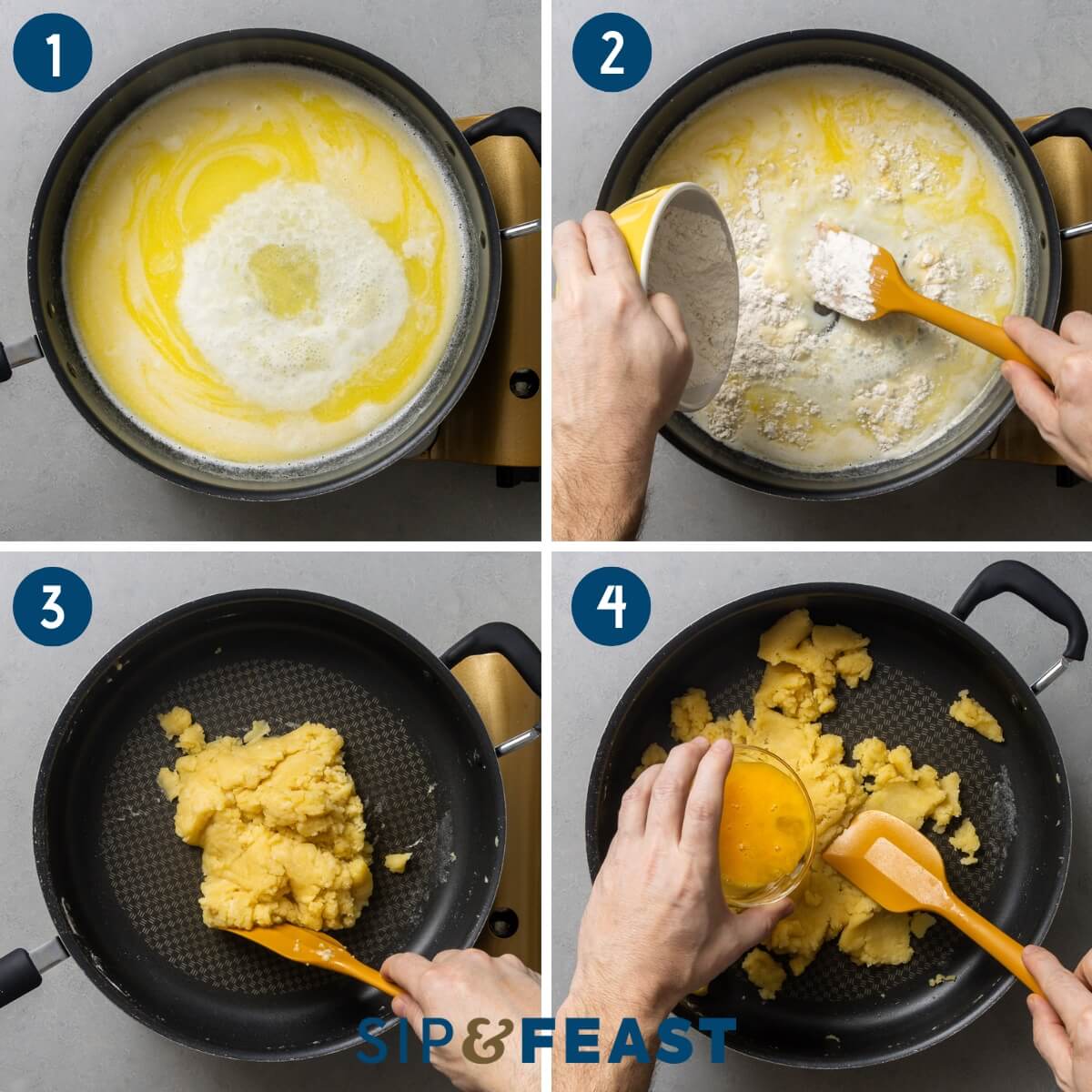
- Continue to stir until the mixture forms a ball, about 2 minutes. (Photo #3)
- Remove the pan from the heat and use a spatula to move the dough around to cool it down. Wait at least 5 minutes, before adding the eggs, then add 1 beaten egg and mix well until fully incorporated. (Photo #4)
- Add 3 more beaten eggs, one at a time, until the batter has a sheen and is pliable. (Photo #5)
- Fit a pastry bag with a star tip, then fill with the dough. (Photo #6)
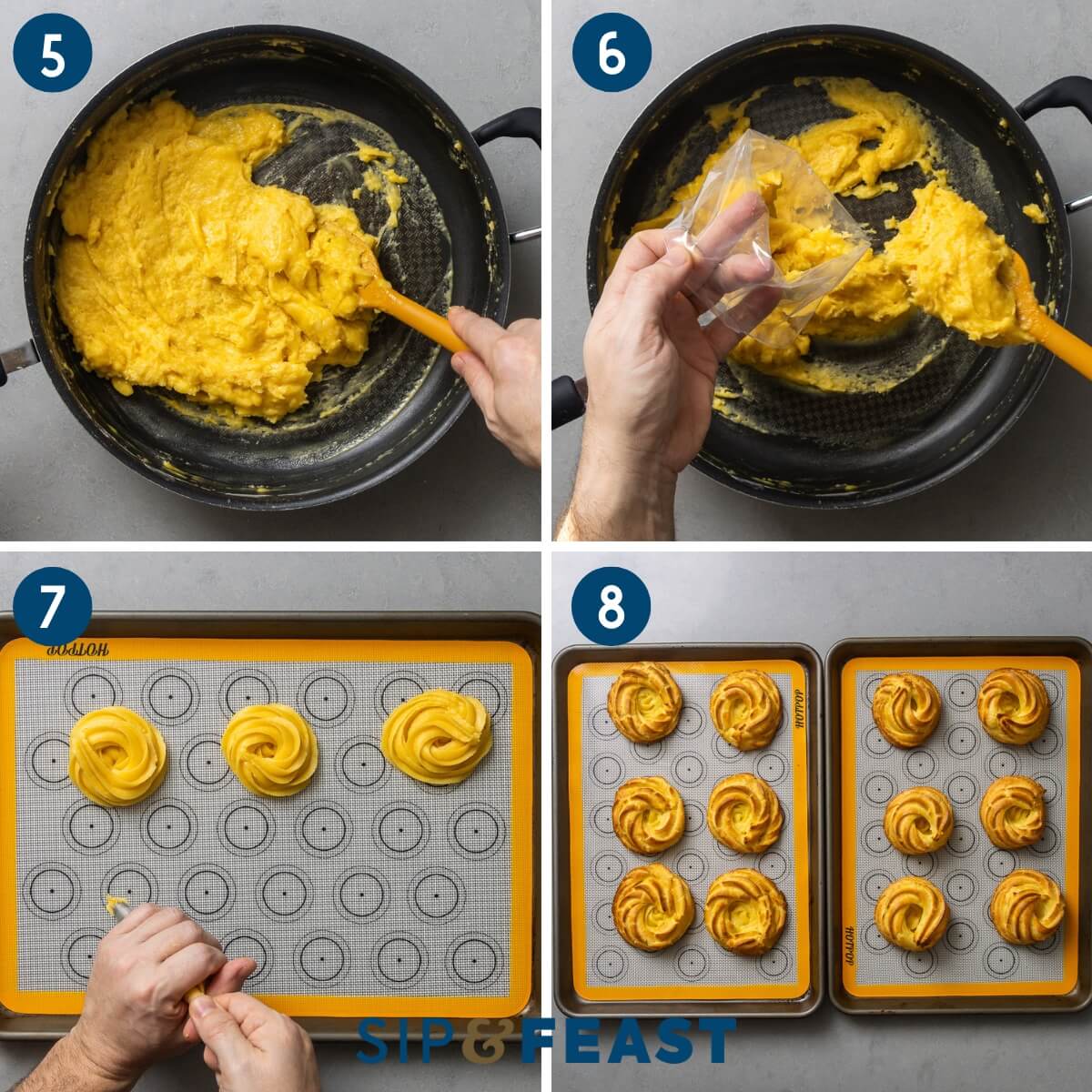
- Prepare 2 baking sheets with parchment paper or silicon mats and begin to pipe 3-inch circles in two layers, starting from the inside on the first layer. Leave a hole in the top of the second layer for the pastry cream. Make sure to leave at least 3 inches of room between each because they will expand during baking. (Photo #7)
- Bake the pastry dough for 25-30 minutes or until they turn lightly golden, then remove them from the oven and after 10 minutes, transfer to a wire rack to finish cooling. (Photo #8)
Next, make the pastry cream and finish the zeppole
Note: Both the baked zeppole and pastry cream need to be cool before filling. While it doesn’t matter which process you start with, making the pastry cream one day in advance and refrigerating overnight is a better workflow.
- Prepare a large bowl filled with ice water and set aside. In a medium saucepan over low heat, warm 2 cups (480g) of whole milk and 2 teaspoons (9g) of vanilla extract. (Photo #1)
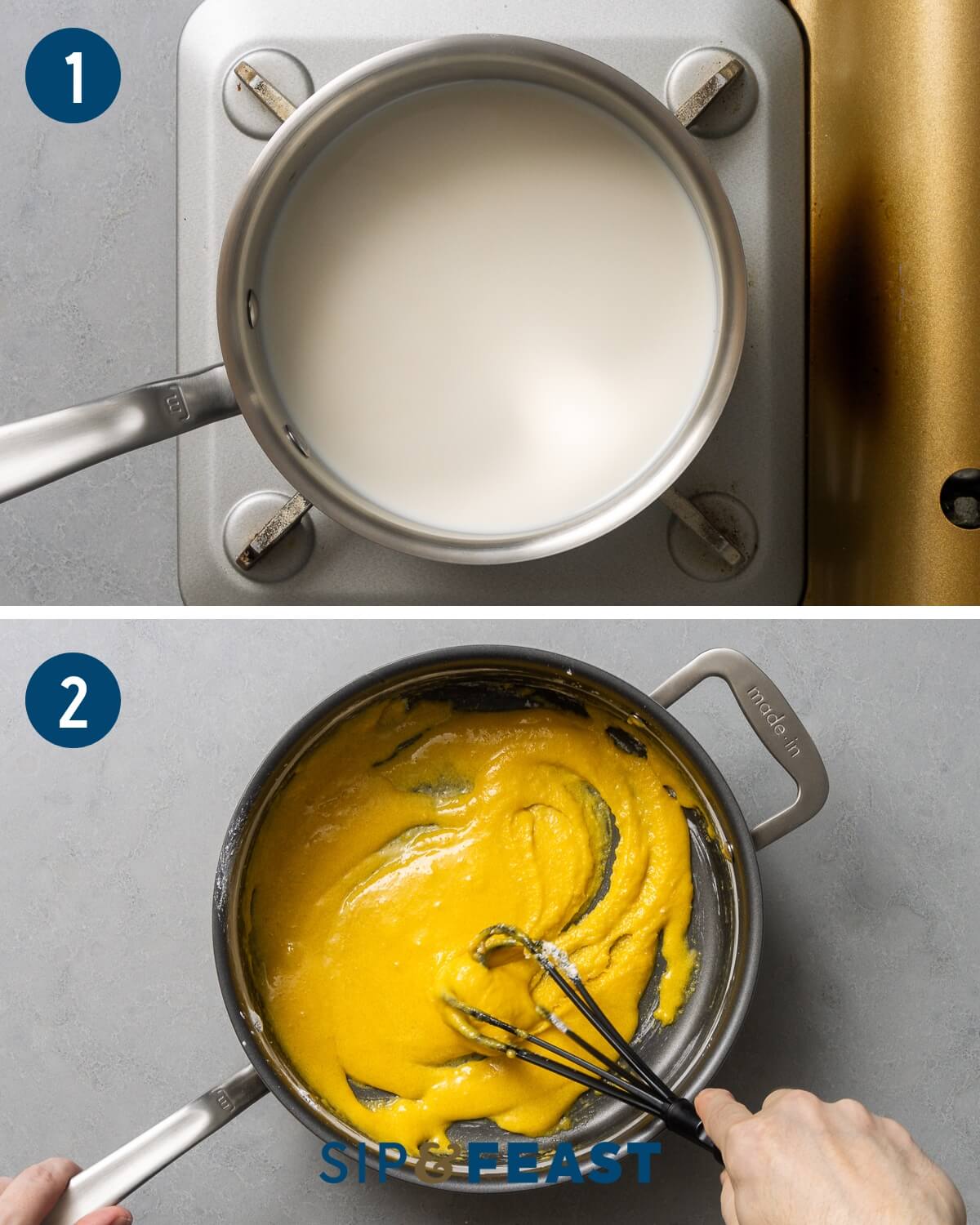
- To a separate saucepan (not on the stove) add 4 large egg yolks, 1/2 cup (100g) of granulated sugar, and 1/4 cup (35g) of cornstarch and whisk until combined. (Photo #2)
- Place the pot on a burner and begin whisking in the warm milk, then turn the heat to medium and continue to whisk. (Photo #3)
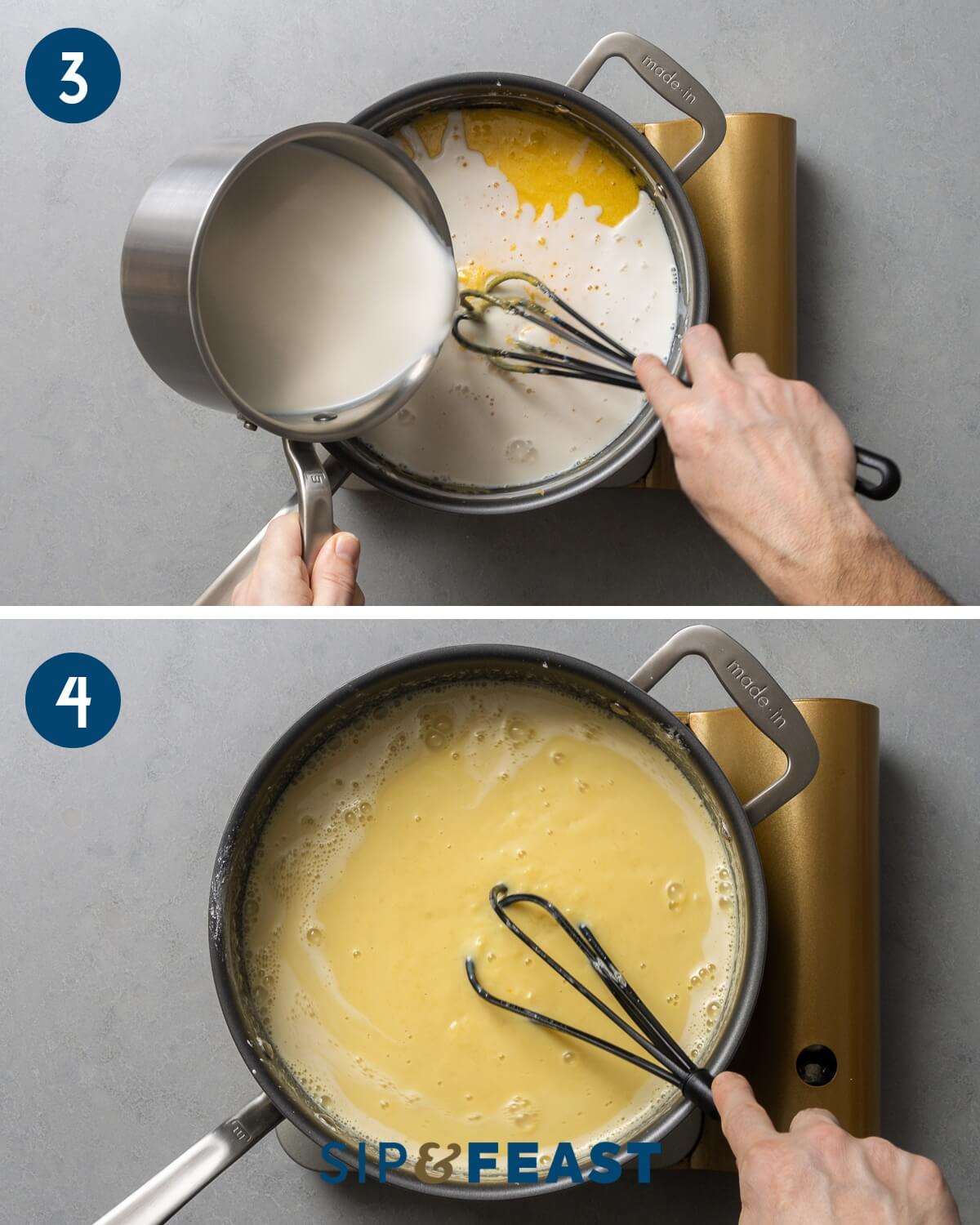
- Slowly increase the heat while continuing to whisk. (Photo #4)
- Let the mixture come to a boil for 2-3 minutes or until it thoroughly coats the back of a spoon. (Photo #5)
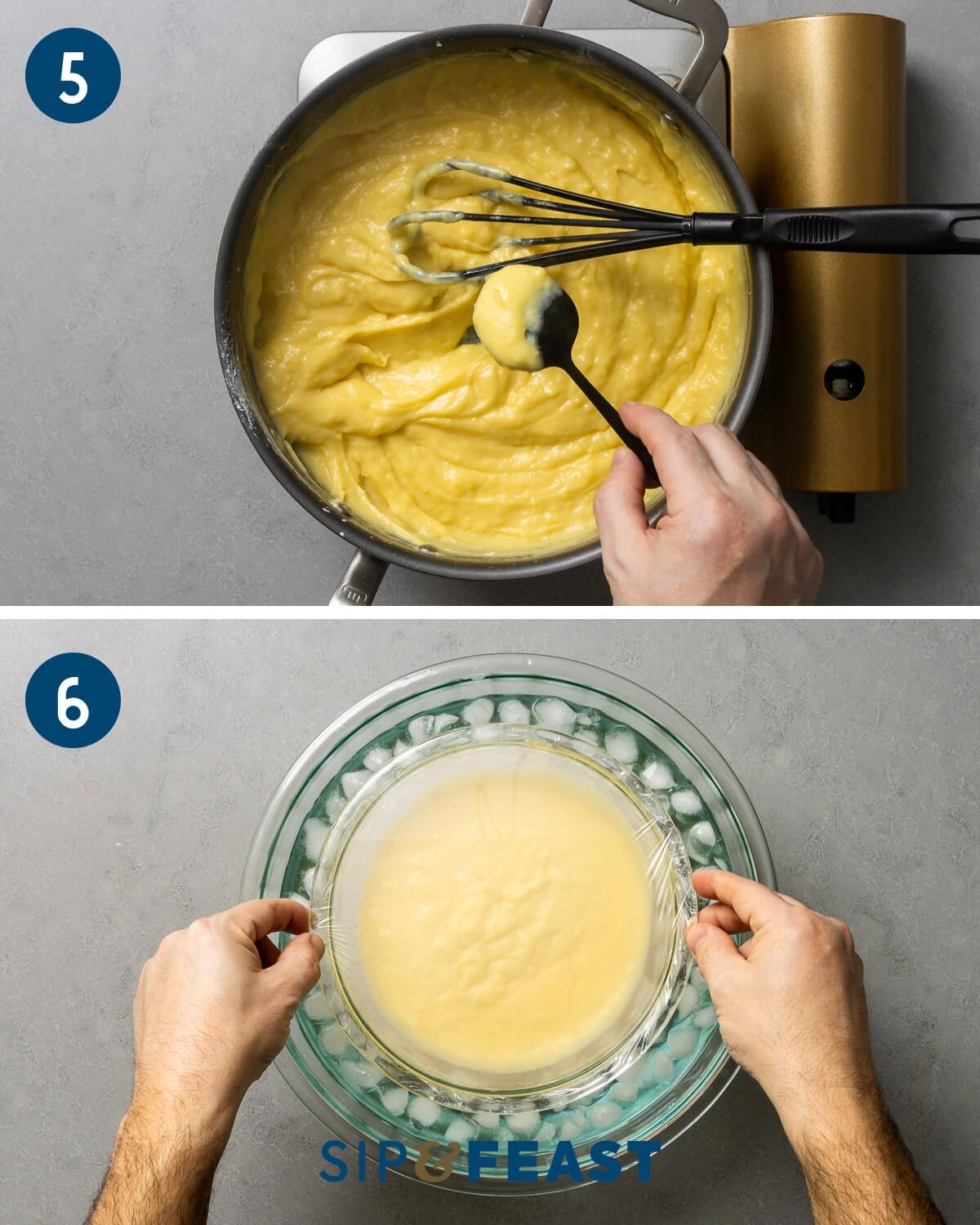
- Pour the pastry cream into a medium bowl and tightly cover with plastic wrap then place the bowl into the larger bowl of ice water. Once the cream is cold, remove the bowl from the ice water and move on to filling the pastries, or allow the cream to sit and cool in the fridge overnight. (Photo #6)
- Once the pastry cream is cool, slice the pastry in half for easy filling, or if the area with the hole is large enough to accommodate the cream, forgo the slicing. Note: In the collage below the zeppole to the left has plenty of room for piping while the one in my hands needs to be cut open. (Photo #7)
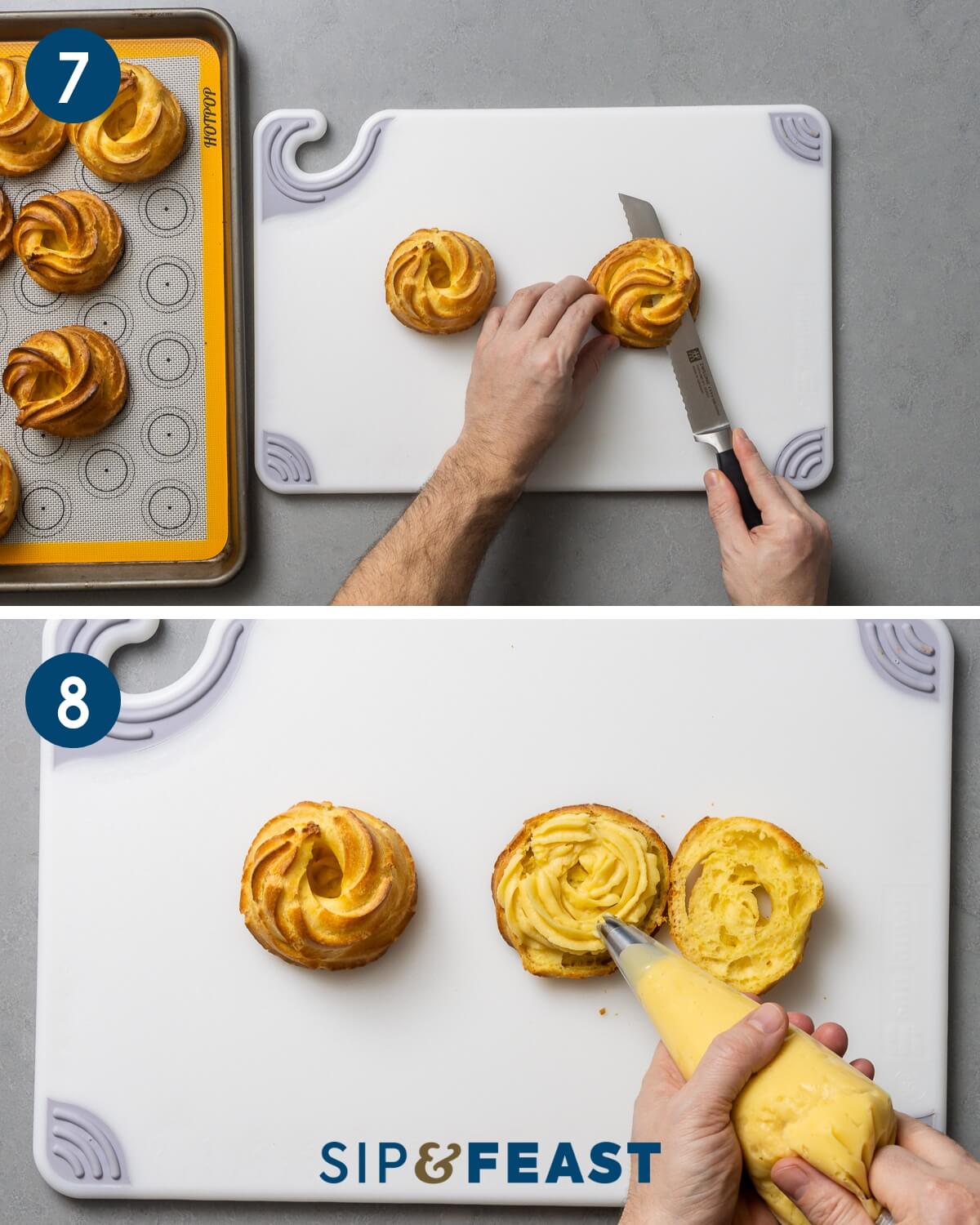
- Place the cooled cream into a pastry bag fitted with a star tip and begin to fill the bottom of the pastry with the cream, then place the top back on like a sandwich. (Photo #8)
- Pipe more cream onto the top keeping the diameter smaller than that of the zeppole. (Photo #9)
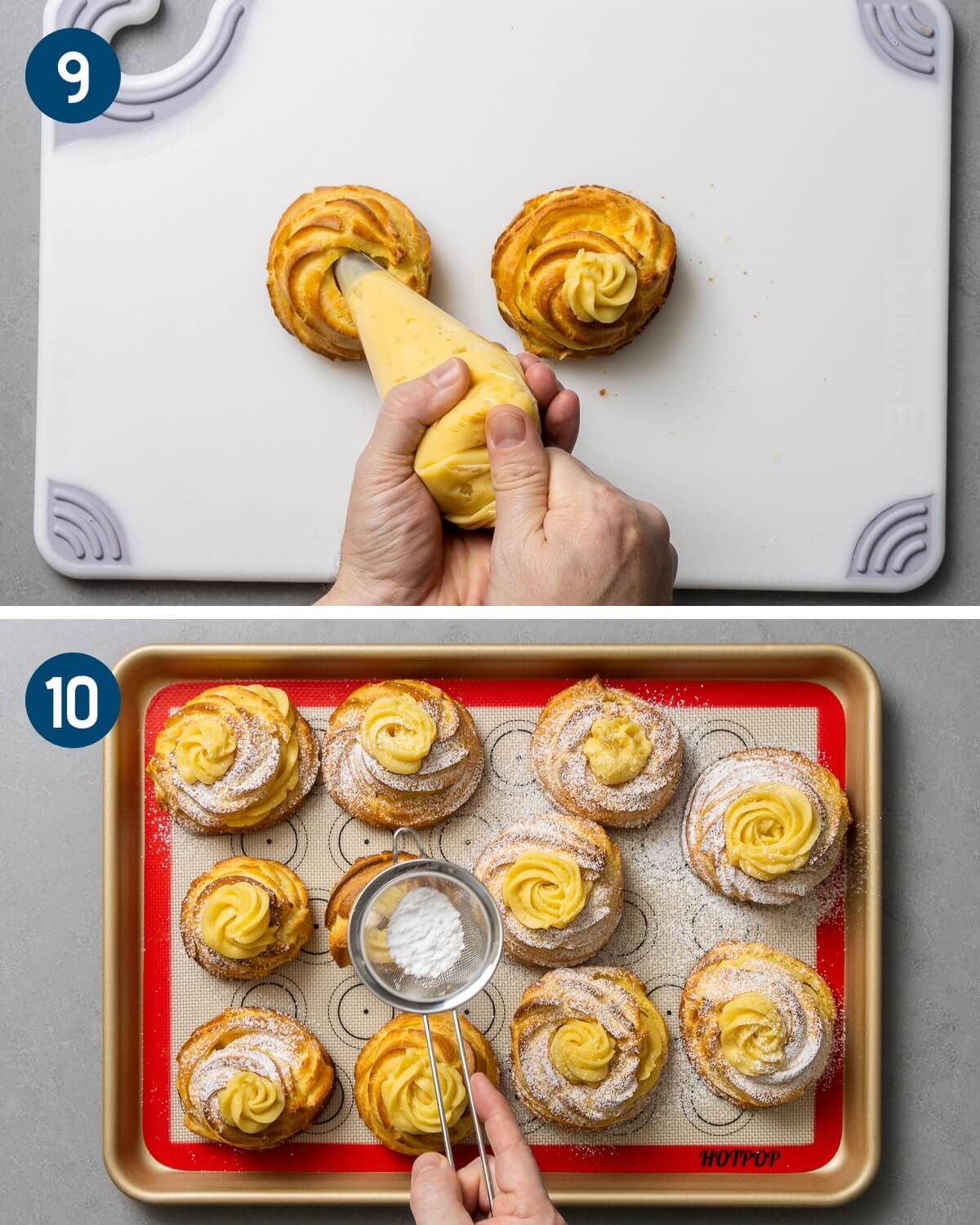
- Sprinkle with powdered sugar first, then top with 1-2 Amarena cherries or any cherry you like, if desired, and enjoy! (Photo #10)
Top tips
- Pastry cream consistency. As simple as it seems, pastry cream can be finicky in that you can easily wind up with cream that’s either too thick or too thin. Your best bet is to err on the side of being too thick, and then add 1 teaspoon of milk at a time to thin it out. When you start, if you find your cream is too thin after adding the 1/4 cup (35g) of cornstarch, you can add 1 teaspoon of cornstarch at a time until the desired thickness is reached.
- Choux dough. In Italy the choux dough for Zeppole di San Giuseppe is often fried. I prefer to bake mine because it’s much easier and almost as good! However, if you wish to fry, you can par-bake the pastries, and fry them in a neutral-flavored oil, similar to how you would regular zeppole.
- Cherries. Maraschino cherries are widely available so if you need to use them, you can certainly do so, however, I prefer the look and taste of the darker Amarena cherries. You can find these in specialty grocery stores, Amazon, and Trader Joe’s often carries them as well. Rinsing the cherries helps remove the liquid so that they don’t drip down the zeppole.
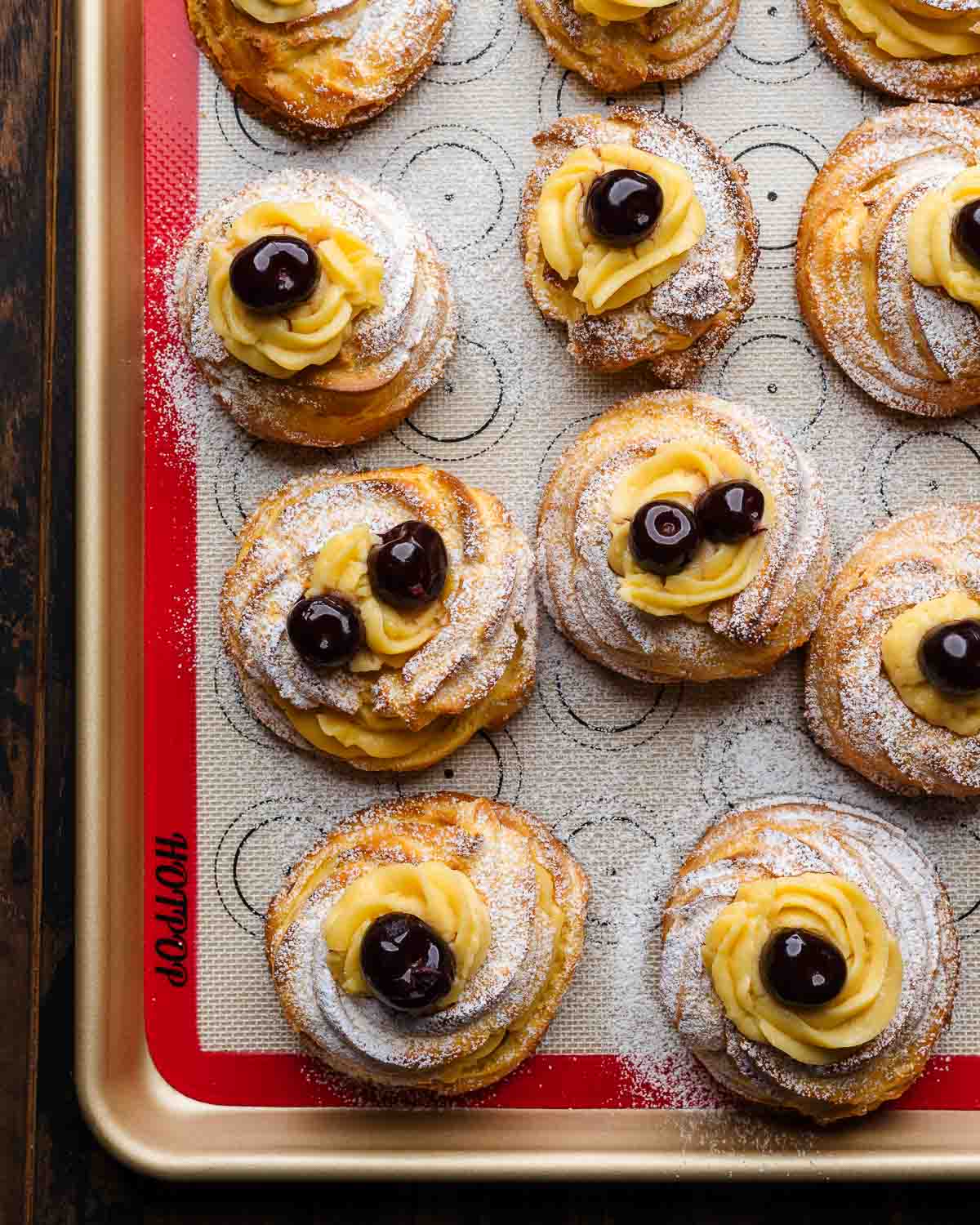
More Italian Desserts
If you love these San Giuseppe pastries, here are a few more recipes I think you’ll enjoy!
If you’ve enjoyed this Zeppole di San Giuseppe (St. Josephy’s Day Pastries) Recipe or any recipe on this site, give it a 5-star rating and tell us about it in the comments below.
We strive to satisfy a number of learning styles. If you are someone who prefers to learn by watching, you can find most of our recipes on YouTube and our Facebook Page.
Zeppole di San Giuseppe (St. Joseph’s Day Pastries)

Ingredients
For the choux pastry
- 1 stick (115g) unsalted butter
- 2 teaspoons (9g) granulated sugar
- 1 pinch fine sea salt
- 1/2 cup (120g) whole milk
- 1/2 cup (120g) water
- 1 1/4 cups (160g) all-purpose flour
- 4 large eggs beaten
For the pastry cream
- 4 large egg yolks
- 2 cups (480g) whole milk warmed
- 1/2 cup (100g) granulated sugar
- 2 teaspoons (9g) vanilla extract
- 1/4 cup (35g) cornstarch
Toppings
- Amarena cherries or any cherries you like
- powdered sugar
Want To Save This Recipe?
Instructions
For the choux pastry
- Preheat oven to 400f and set the rack on the middle level.
- Place the butter, sugar, water, and milk in a large saucepan. Turn the heat to medium and let the mixture come up to a boil.
- Once boiling, add the flour and using a spatula stir well until all of the flour is incorporated and the mixture comes together into a ball (about 2 minutes).
- Remove the pan from the heat and move the dough around with the spatula to cool it down. Wait at least 5 minutes before adding the eggs.
- Add one lightly beaten egg and mix well until it is fully incorporated. Repeat the process for the remaining eggs, one at a time. The batter should have a sheen and be pliable and easy to pipe.
- Place the dough into a piping bag with a star tip. Prepare baking sheets lined with either silicon or parchment paper. Pipe 3-inch circles in two layers, starting from the inside on the first layer. Leave a hole in the top of the second layer for the pastry cream. Make sure to leave at least 3 inches of room between each because they will expand during baking.
- Bake for 25-30 minutes or until they turn lightly golden. Remove from the oven and after 10 minutes transfer to a wire rack to finish cooling.
For the pastry cream
- Prepare a large bowl filled with ice water.
- In a medium saucepan over low heat, warm up the milk and vanilla.
- To a separate saucepot (not on the stove) add the egg yolks, sugar, and cornstarch and whisk until combined. Place the pot onto a burner then begin whisking in the warm milk.
- Next, turn the heat to medium and continue to whisk. Slowly increase the heat, while continuing to whisk. Let the mixture come to a boil for 2-3 minutes or until it thoroughly coats the back of a wooden spoon.
- Pour the pastry cream into a medium bowl and tightly cover with plastic wrap. Place the bowl into the larger bowl of ice water. Once the cream is cold remove the bowl from the ice water and move on to filling the pastries.
Piping and finishing the pastries
- Slice the pastry in half for easy filling or if a large enough area was made for holding the filling forgo the slicing of the pastry.
- Place the cooled pastry cream into a piping bag with a star tip. Fill the bottom of the pastry with cream then close it up like a sandwich. Top with more cream but smaller in diameter than the zeppole.
- Sprinkle with powdered sugar then place 1 or 2 cherries on top. Enjoy!
Notes
- This recipe yields 8-10 pastries that are roughly 3 inches in diameter.
- Traditionally, St. Jospeph Day Pastries are fried. If you would like to do this, parbake for only 10 minutes then let them cool before deep frying in 350f vegetable oil until golden. Parbaking is recommended because it is very hard to add the piped dough straight into the oil without deforming the pastries.
- The pastry cream should be fairly thick so that it doesn’t fall out of the tip of the pastry bag. However, if the cream is too thick, thin with a teaspoon of milk at a time and whisk until the desired consistency is achieved.
- Leftovers can be stored in the fridge for up to 3 days or they can be frozen for up to 3 months.
Nutrition
Nutrition information is automatically calculated, so should only be used as an approximation.
Follow Me







/
Love this recipe, it is so easy to follow. James always makes it easy to follow. Very practical, but lots of deliciousness! Thank you
We’re so happy you enjoyed, Marie!
James, this recipe is perfection! The choux dough came together beautifully and the pastry cream was silky and smooth. Thank you!
Sara
Hi Sara, we’re so happy to hear you enjoyed the zeppole and appreciate your comment!
What number star tip is used ?
Ateco #828 or #829 would both work.
Thank you James
I will try making these.
Do you have recipe for ricotta filling?
Hi Veronica, these pastries are traditionally made with pastry cream. We do use ricotta impastata for our cannoli filling and you can find that recipe here: https://www.sipandfeast.com/cannoli/
delicious. exactly how I remembered them when I lived in Brooklyn N Y
We’re so happy you enjoyed these, Grace!
Can the unfilled shells be frozen?
Yes, definitely.